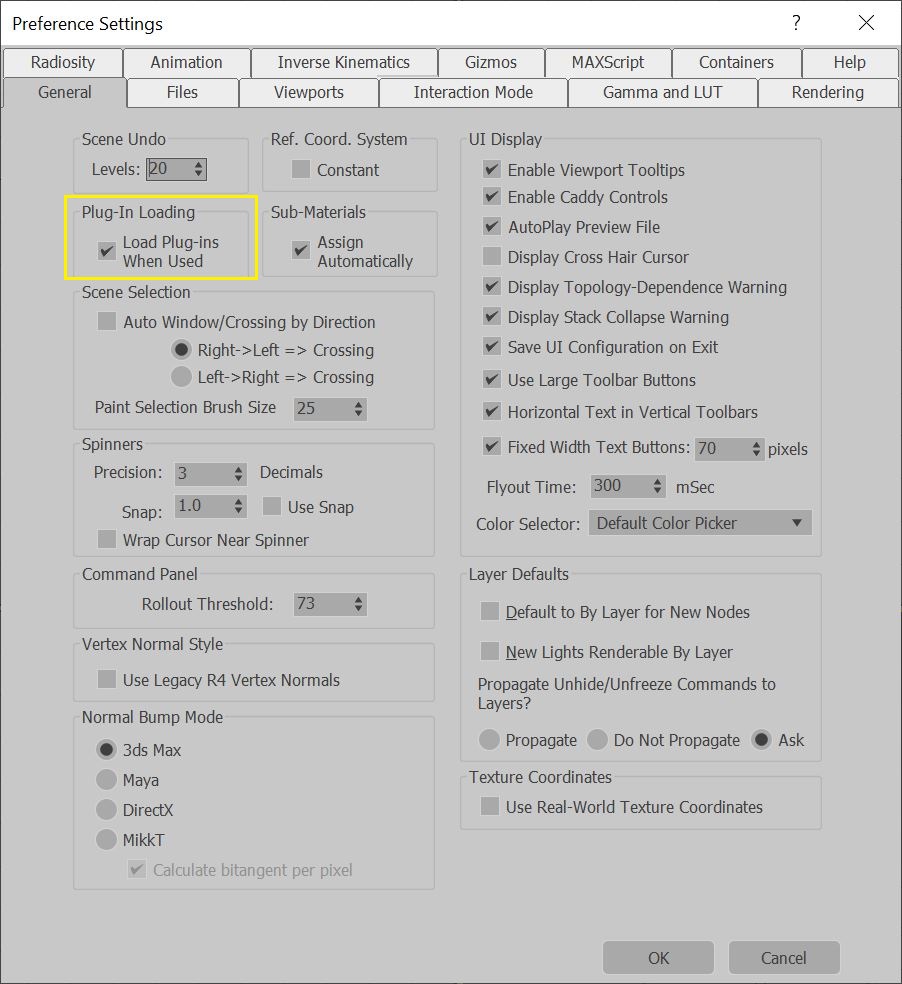
Found this thread for solving the sluggish UI on 3DS MAX.
Issue:
3ds Max lags or shows a delay in performance, even on fast CPUs. This includes, but is not limited to Intel i9 and AMD ‘Ryzen Threadrippers’.
This includes clicking any area of the user interface or moving objects, animation playback (FPS, or frames per second) in the viewport.
When trying to move an object from point A to point B, it may take two – ten seconds to perform the action.
Environment:
- AMD Ryzen CPUs.
- AMD Threadripper.
- Intel i9 CPUs.
Causes:
Includes, but is not limited to:
- Under certain PC hardware configurations, the multicore CPU’s cache memory access may become bottle-necked when performing certain calculations. The CPUs may run fast as long as they can hit the data they need directly (in the cache), but can become stalled when hitting a “cache miss.”.
- Outdated video card drivers.
- Power management options in Windows may be switching between a slower, low-power onboard graphics processing unit (GPU) and a higher-performance video card.
- Large 3ds Max scene files (more than 1 gigabyte) with many objects and high-resolution textures.
- High-resolution monitor settings or multiple monitors connected to laptop docks.
- Corrupted scene geometry.
- Dense, high poly objects.
Solution:
The solution may require one, or a combination of the following to resolve:
Check the scene for corrupted scripts
Go to the Script Controller entry in the ‘See Also’ section below to check 3ds Max for corrupted scripts that could affect performance.
Turn off Deferred Plug-in Loading
- In 3ds Max, go to the Customize > Preferences menu.
- In the General tab, deselect “Load Plug-ins When Used.”
- Close 3ds Max, then restart the program.

Disable Hyperthreading (for Intel CPUs) or Simultaneous Multithreading (SMT, for AMD CPUs)
Although it may seem contradictory, disabling Hyperthreading (for Intel CPUs) or SMT (simultaneous
multithreading, for AMD CPUs) may actually speed up 3ds Max performance.
Note: The Arnold renderer takes advantage of both Hyperthreading and SMT, so disable these settings only if getting the best performance from Arnold isn’t necessary.
Set a Qt Environment variable in Windows
In some instances, 3ds Max UI improvements may occur by setting a Qt (UI) environment variable in Windows:
- In Windows (8 or 10), go to the Windows Search bar.
- Type: System. (It should bring up the choice of “System (Control Panel).”
- Press Enter.
- In the System menu, in the bottom-left of the menu, click the Advanced Systems Settings item. A System Properties menu will appear.
- Click Environment Variables. The Environment Variables menu will appear.
- Under System variables, click New to bring up the New System Variable menu.
- Under Variable name, enter: QT_OPENGL
- Under Variable value, enter: Angle
- Click OK in to save the changes.
- Under System variables, click New to bring up the New System Variable menu.
- Under Variable name, enter: QT_ANGLE_PLATFORM
- Under Variable value, enter any one of these variables: warp, d3d9 or d3d11. (Note: Save only one of these at a time. If you see no improvement, reboot the PC and repeat the process but enter the next variable in this list.)
- Click OK in each menu to save the changes.
- Reboot the PC and test the performance in 3ds Max.
For more information on the Qt variables, see: Qt 5 on Windows ANGLE and OpenGL.
Update Graphics Drivers
To install the most recent version of the video card driver, update the GPU from the manufacturer’s website:.
Configure the PC or laptop to use high-performance graphics
See the following articles:
- How to configure Autodesk software to use high-performance graphics.
- Crash on systems with integrated (Intel HD) and discrete GPUs (NVIDIA/AMD).
Optimize 3ds Max scenes
Follow the steps in this article to optimize large scene for best performance in 3ds Max: How to optimize performance in large 3ds Max scenes .
Lower the display resolution if necessary
If running in 4K resolution and encountering screen redraw issues (especially if running multiple monitors), consider lowering the screen resolution. See this Microsoft article for recommended screen settings:
.
Examine the scene for corrupted geometry
In certain cases, having corrupted scene geometry can impair viewport performance. Try the following:
- Use the Subobject: Vertex > Delete Isolated Vertices feature in case geometry vertices have become detached and are located far from the base object. For similar troubleshooting steps, see Objects in 3ds Max have Polygon Shading or Normal problems, appear “fuzzy” or render incorrectly .
- Try collapsing all object Modifier stacks.
- Use the following steps to isolate problematic objects and either rebuild them or remove them from the scene.
Optimize high poly objects
High poly objects will impact viewport performance. Use Xrefs where possible.